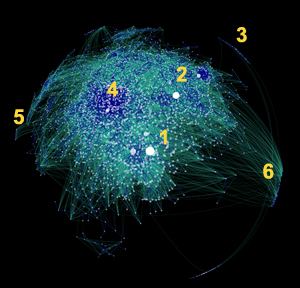 | ||
The blogosphere is made up of all blogs and their interconnections. The term implies that blogs exist together as a connected community (or as a collection of connected communities) or as a social networking service in which everyday authors can publish their opinions. Since the term has been coined, it has been referenced in a number of media and is also used to refer to the Internet.
Contents
History
The term was coined on September 10, 1999 by Brad L. Graham, as a joke. It was re-coined in 2002 by William Quick, and was quickly adopted and propagated by the warblog community. The term resembles the older word logosphere (from Greek logos meaning word, and sphere, interpreted as world), "the world of words", the universe of discourse.
Despite the term's humorous intent, CNN, the BBC, and National Public Radio's programs Morning Edition, Day To Day, and All Things Considered have used it several times to discuss public opinion. A number of media outlets in recent years have started treating the blogosphere as a gauge of public opinion, and it has been cited in both academic and non-academic work as evidence of rising or falling resistance to globalization, voter fatigue, and many other phenomena, and also in reference to identifying influential bloggers and "familiar strangers" in the blogosphere.
Proliferation
In 1999, Pyra Labs opened blogging to the masses by simplifying the process of creating and maintaining personal web spaces. Prior to the creation of Pyra's "Blogger", the number of blogs in existence was thought to be less than one hundred, which was thought to be the fetal stage of Blogosphere. Blogger meant the birth of blogosphere. In 2005, a Gallup poll showed that a third of Internet users read blogs at least on occasion, and in May 2006, a study showed that there were over forty-two millions bloggers contributing to the blogosphere. With less than 1 million blogs in existence at the start of 2003, the number of blogs had doubled in size every six months through 2006.
In 2011, it was estimated that there are more than 158 million identified blogs, with more than 1 million new posts being produced by the blogosphere each day.
Revenue
In a 2010 Technorati study, 36% of bloggers reported some sort of income from their blogs, most often in the form of ad revenue. This shows a steady increase from their 2009 report, in which 28% of the blogging world reported their blog as a source of income, with the mean annual income from advertisements at $42,548. Other common sources of blog-related income are paid speaking engagements and paid postings. Paid postings may be subject to rules on clearly disclosing commercial advertisements as such (regulated by, for example, the Federal Trade Commission in the US and the Advertising Standards Authority in the UK).
As a social network
Sites such as Technorati, BlogPulse, and Tailrank track the interconnections between bloggers. Taking advantage of hypertext links which act as markers for the subjects the bloggers are discussing, these sites can follow a piece of conversation as it moves from blog to blog. These also can help information researchers study how fast a meme spreads through the blogosphere, to determine which sites are the most important for gaining early recognition. Sites also exist to track specific blogospheres, such as those related by a certain genre, culture, subject matter, or geopolitical location.
Mapping
In 2007, following six weeks of observation, social media expert Matthew Hurst mapped the blogosphere, generating the plot to the left based on the interconnections between blogs. The most densely populated areas represent the most active portions of the blogosphere. White dots represent individual blogs. They are sized according to the number of links surrounding that particular blog. Links are plotted in both green and blue, with green representing one-way links and blue representing reciprocal links.
DISCOVER Magazine described six major 'hot spots' of the blogosphere. While points 1 and 2 represent influential individual blogs, point 3 is the perfect example of "blogging island", where individual blogs are highly connected within a sub-community but lack many connections to the larger blogosphere. Point 4 describes a sociopolitical blogging niche, in which links demonstrate the constant dialogue between bloggers who write about the same subject of interest. Point 5 is an isolated sub-community of blogs dedicated to the world of pornography. Lastly, point 6 represents a collection of sports' lovers who largely segregate themselves but still manage to link back to the higher traffic blogs toward the center of the blogosphere.
Merging with other social networks
With the outstanding growth of the blogosphere within the past decade, the blogosphere has developed as its own network of interconnections. In this time, bloggers have similarly begun to engage in other online communities, specifically social networking sites, melding the two realms of social media together.
According to Technorati's 2010 "State of Blogosphere" report, 78% of bloggers are using Twitter, with much larger percentages of individuals who blog as part-time jobs (88%) or who blog full-time for a specific company (88%) using "the microblogging service". Almost half of all bloggers surveyed use Twitter to interact with the readers of their blog, while 72% of bloggers use Twitter for blog promotion. For bloggers whose blog is their business (self-employed), 63% use Twitter to market their business. Additionally, according to the report, almost 9 out of 10 (87%) bloggers currently use Facebook.
Blogging niches
Within the blogosphere, several sub-communities have developed. These communities are largely divided by genre. Blogs are often identified by a specific genre or topic, such as travel or politics.
